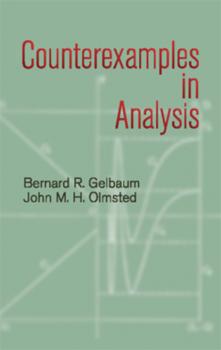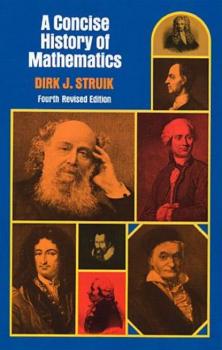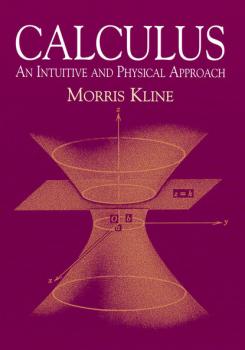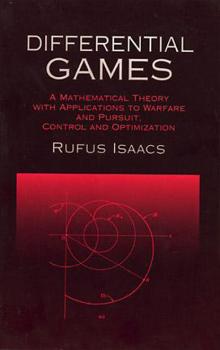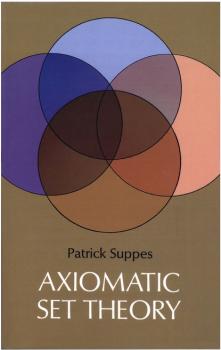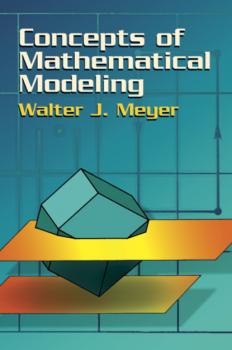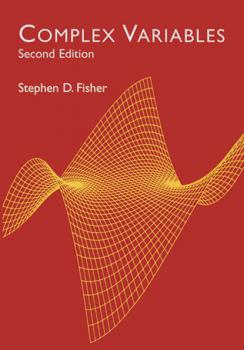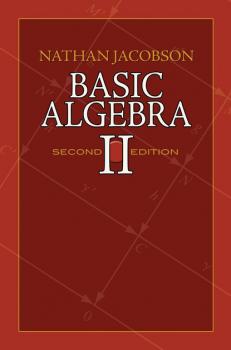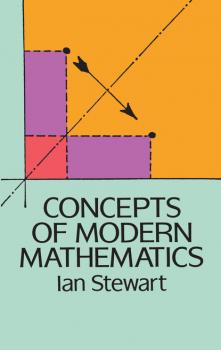ТОП просматриваемых книг сайта:
Dover Books on Mathematics
Скачать книги из серии Dover Books on MathematicsАннотация
These counterexamples, arranged according to difficulty or sophistication, deal mostly with the part of analysis known as «real variables,» starting at the level of calculus. The first half of the book concerns functions of a real variable; topics include the real number system, functions and limits, differentiation, Riemann integration, sequences, infinite series, uniform convergence, and sets and measure on the real axis. The second half, encompassing higher dimensions, examines functions of two variables, plane sets, area, metric and topological spaces, and function spaces. This volume contains much that will prove suitable for students who have not yet completed a first course in calculus, and ample material of interest to more advanced students of analysis as well as graduate students. 12 figures. Bibliography. Index. Errata.
Аннотация
This compact, well-written history — first published in 1948, and now in its fourth revised edition — describes the main trends in the development of all fields of mathematics from the first available records to the middle of the 20th century. Students, researchers, historians, specialists — in short, everyone with an interest in mathematics — will find it engrossing and stimulating.Beginning with the ancient Near East, the author traces the ideas and techniques developed in Egypt, Babylonia, China, and Arabia, looking into such manuscripts as the Egyptian Papyrus Rhind, the Ten Classics of China, and the Siddhantas of India. He considers Greek and Roman developments from their beginnings in Ionian rationalism to the fall of Constantinople; covers medieval European ideas and Renaissance trends; analyzes 17th- and 18th-century contributions; and offers an illuminating exposition of 19th century concepts. Every important figure in mathematical history is dealt with — Euclid, Archimedes, Diophantus, Omar Khayyam, Boethius, Fermat, Pascal, Newton, Leibniz, Fourier, Gauss, Riemann, Cantor, and many others. For this latest edition, Dr. Struik has both revised and updated the existing text, and also added a new chapter on the mathematics of the first half of the 20th century. Concise coverage is given to set theory, the influence of relativity and quantum theory, tensor calculus, the Lebesgue integral, the calculus of variations, and other important ideas and concepts. The book concludes with the beginnings of the computer era and the seminal work of von Neumann, Turing, Wiener, and others."The author's ability as a first-class historian as well as an able mathematician has enabled him to produce a work which is unquestionably one of the best." — Nature Magazine.
Аннотация
Application-oriented introduction relates the subject as closely as possible to science. In-depth explorations of the derivative, the differentiation and integration of the powers of x, and theorems on differentiation and antidifferentiation lead to a definition of the chain rule and examinations of trigonometric functions, logarithmic and exponential functions, techniques of integration, polar coordinates, much more. Clear-cut explanations, numerous drills, illustrative examples. 1967 edition. Solution guide available upon request.
Аннотация
One of the definitive works in game theory, this fascinating volume offers an original look at methods of obtaining solutions for conflict situations. Combining the principles of game theory, the calculus of variations, and control theory, the author considers and solves an amazing array of problems: military, pursuit and evasion, games of firing and maneuver, athletic contests, and many other problems of conflict.Beginning with general definitions and the basic mathematics behind differential game theory, the author proceeds to examinations of increasingly specific techniques and applications: dispersal, universal, and equivocal surfaces; the role of game theory in warfare; development of an effective theory despite incomplete information; and more. All problems and solutions receive clearly worded, illuminating discussions, including detailed examples and numerous formal calculations.The product of fifteen years of research by a highly experienced mathematician and engineer, this volume will acquaint students of game theory with practical solutions to an extraordinary range of intriguing problems.
Аннотация
One of the most pressingproblems of mathematics over the last hundred years has been the question: What is a number? One of the most impressive answers has been the axiomatic development of set theory. The question raised is: «Exactly what assumptions, beyond those of elementary logic, are required as a basis for modern mathematics?» Answering this question by means of the Zermelo-Fraenkel system, Professor Suppes' coverage is the best treatment of axiomatic set theory for the mathematics student on the upper undergraduate or graduate level. The opening chapter covers the basic paradoxes and the history of set theory and provides a motivation for the study. The second and third chapters cover the basic definitions and axioms and the theory of relations and functions. Beginning with the fourth chapter, equipollence, finite sets and cardinal numbers are dealt with. Chapter five continues the development with finite ordinals and denumerable sets. Chapter six, on rational numbers and real numbers, has been arranged so that it can be omitted without loss of continuity. In chapter seven, transfinite induction and ordinal arithmetic are introduced and the system of axioms is revised. The final chapter deals with the axiom of choice. Throughout, emphasis is on axioms and theorems; proofs are informal. Exercises supplement the text. Much coverage is given to intuitive ideas as well as to comparative development of other systems of set theory. Although a degree of mathematical sophistication is necessary, especially for the final two chapters, no previous work in mathematical logic or set theory is required. For the student of mathematics, set theory is necessary for the proper understanding of the foundations of mathematics. Professor Suppes in Axiomatic Set Theory provides a very clear and well-developed approach. For those with more than a classroom interest in set theory, the historical references and the coverage of the rationale behind the axioms will provide a strong background to the major developments in the field. 1960 edition.
Аннотация
Appropriate for undergraduate and graduate students, this text features independent sections that illustrate the most important principles of mathematical modeling, a variety of applications, and classic models. Students with a solid background in calculus and some knowledge of probability and matrix theory will find the material entirely accessible. The range of subjects includes topics from the physical, biological, and social sciences, as well as those of operations research. Discussions cover related mathematical tools and the historical eras from which the applications are drawn. Each section is preceded by an abstract and statement of prerequisites, and answers or hints are provided for selected exercises. 1984 edition.
Аннотация
The most important topics in the theory and application of complex variables receive a thorough, coherent treatment in this introductory text. Intended for undergraduates or graduate students in science, mathematics, and engineering, this volume features hundreds of solved examples, exercises, and applications designed to foster a complete understanding of complex variables as well as an appreciation of their mathematical beauty and elegance. <BR>Prerequisites are minimal; a three-semester course in calculus will suffice to prepare students for discussions of these topics: the complex plane, basic properties of analytic functions (including a rewritten and reorganized discussion of Cauchy's Theorem), analytic functions as mappings, analytic and harmonic functions in applications, and transform methods. Useful appendixes include tables of conformal mappings and Laplace transforms, as well as solutions to odd-numbered exercises.<BR>Students and teachers alike will find this volume, with its well-organized text and clear, concise proofs, an outstanding introduction to the intricacies of complex variables.
Аннотация
A classic text and standard reference for a generation, this volume and its companion are the work of an expert algebraist who taught at Yale for more than three decades. Nathan Jacobson's books possess a conceptual and theoretical orientation; in addition to their value as classroom texts, they serve as valuable references.Volume II comprises all of the subjects usually covered in a first-year graduate course in algebra. Topics include categories, universal algebra, modules, basic structure theory of rings, classical representation theory of finite groups, elements of homological algebra with applications, commutative ideal theory, and formally real fields. In addition to the immediate introduction and constant use of categories and functors, it revisits many topics from Volume I with greater depth and sophistication. Exercises appear throughout the text, along with insightful, carefully explained proofs.
Аннотация
Some years ago, «new math» took the country's classrooms by storm. Based on the abstract, general style of mathematical exposition favored by research mathematicians, its goal was to teach students not just to manipulate numbers and formulas, but to grasp the underlying mathematical concepts. The result, at least at first, was a great deal of confusion among teachers, students, and parents. Since then, the negative aspects of «new math» have been eliminated and its positive elements assimilated into classroom instruction.In this charming volume, a noted English mathematician uses humor and anecdote to illuminate the concepts underlying «new math»: groups, sets, subsets, topology, Boolean algebra, and more. According to Professor Stewart, an understanding of these concepts offers the best route to grasping the true nature of mathematics, in particular the power, beauty, and utility of pure mathematics. No advanced mathematical background is needed (a smattering of algebra, geometry, and trigonometry is helpful) to follow the author's lucid and thought-provoking discussions of such topics as functions, symmetry, axiomatics, counting, topology, hyperspace, linear algebra, real analysis, probability, computers, applications of modern mathematics, and much more.By the time readers have finished this book, they'll have a much clearer grasp of how modern mathematicians look at figures, functions, and formulas and how a firm grasp of the ideas underlying «new math» leads toward a genuine comprehension of the nature of mathematics itself.
Аннотация
This classic text by a distinguished mathematician and former Professor of Mathematics at Harvard University, leads students familiar with elementary calculus into confronting and solving more theoretical problems of advanced calculus. In his preface to the first edition, Professor Widder also recommends various ways the book may be used as a text in both applied mathematics and engineering.Believing that clarity of exposition depends largely on precision of statement, the author has taken pains to state exactly what is to be proved in every case. Each section consists of definitions, theorems, proofs, examples and exercises. An effort has been made to make the statement of each theorem so concise that the student can see at a glance the essential hypotheses and conclusions.For this second edition, the author has improved the treatment of Stieltjes integrals to make it more useful to the reader less than familiar with the basic facts about theRiemann integral. In addition the material on series has been augmented by the inclusion of the method of partial summation of the Schwarz-Holder inequalities, and of additional results about power series. Carefully selected exercises, graded in difficulty, are found in abundance throughout the book; answers to many of them are contained in a final section.

